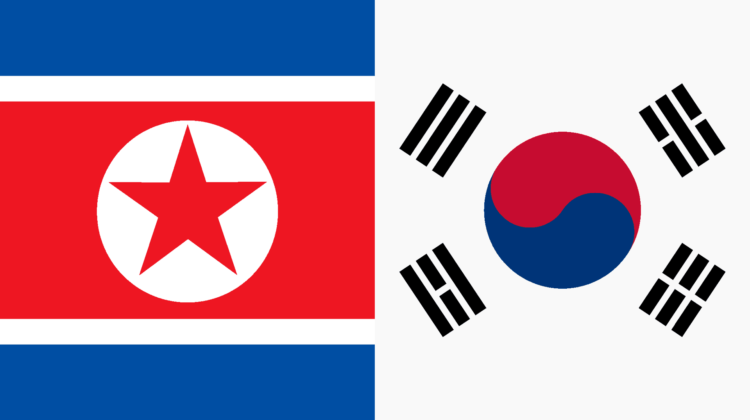
How policy in North Korea is affected by politics in South Korea – and vice versa
Colin Alexander, Nottingham Trent University
In a speech delivered at the Supreme People’s Assembly in January, North Korea’s leader, Kim Jong-Un, stated that reunification with South Korea was no longer possible and that their neighbour should now represent the “primary foe and invariable principal enemy”.
This amounted to a rare foreign policy pivot by Pyongyang, which consistently aimed for reunification of the peninsula since it was divided in the armistice that ended the 1950-1953 war.
Pyongyang’s new position towards the South has been widely interpreted as evidence of warmongering on the part of the North. The South, by contrast, is almost always portrayed as a benign neighbour and an unwilling target for threats of aggression. But it’s not as simple as that.
When it comes to North Korea’s foreign policy shifts, political developments and public opinion in the South plays a key – if often understated – role. Pyongyang must also take domestic factors into consideration when making statements about peninsular relations.
Politics in South Korea
Relations with the North are one of the most contentious issues in South Korean politics. Changes in power between political parties can often result in policy pivots in Seoul from hostility to reconciliation and back to hostility. Efforts towards friendlier peninsular relations are known as the “sunshine policy” in Seoul.
South Korea’s presidential system limits presidents to a single five-year term. This means that presidents interested in improving relations with Pyongyang only have a few years to make progress before leaving office. For continuity to be guaranteed, the incumbent president is reliant upon their successor being similarly minded and possibly even part of the diplomatic team in a junior or advisory role and so already known to North Koreans.
These circumstances are difficult to manufacture though. Meaning that most of what is agreed by the South during friendlier times amounts to minor or temporary bridge building, which is a considerable frustration to the North.
For example, Pyongyang and Seoul made strides towards better relations during the recent five-year presidency of Moon Jae-in between 2017 and 2022. This led to the landmark moment in April 2018 when the two leaders met at the Demilitarised Zone along the 38th parallel. Each leader stepped into the other’s country. Indeed, at the subsequent press event Kim spoke – albeit clumsily from notes and with his head down – of the two Koreas as “one nation” and of his personal desire to see reunification. Moon made similar utterances of further cooperation.
Moon’s efforts towards dialogue with the North – without receiving from Pyongyang any concrete commitments to denuclearisation in return – was widely criticised as weakness by his opponents. It was one of the main reasons his democratic party lost the 2022 presidential election. Critics even referred to Moon’s efforts as the “moonshine policy” in reference to the illegal homemade liquor guaranteed to induce intoxication.
When it comes to the South’s attitude towards the North, it’s important to realise that weapons manufacturers engage in sophisticated and well-funded lobbying efforts around the world. These are usually accompanied by mainstream news and social media campaigns and thinktank reports, reflecting a vested interest for some in keeping tensions high for financial gain.
In the aftermath of Moon’s presidency, the new administration of Yoon Suk Yeol of the People Power Party (from 2022 to the present) has taken a much tougher stance on North Korea. He has demanded “denuclearization first”, before any warming of relations. Yoon has also been critical of the South’s military capacity to deal with North Korean aggression and has pledged to increasing spending on technological advancements.
To this end, the fluctuating position of the South towards the North, alongside the limitations to progress caused by its political system, ought to receive greater recognition as a contributing factor to Pyongyang’s decision to declare the prospect of reunification to be dead.
Domestic concerns in the North
North Korea is one of the most militarised societies in the world. This occurs in two ways. First, on account of the number of people whose livelihoods are attached to a thriving military in one form or another. And second, in terms of the important cultural space that the military takes within public life.
The North Korean military is widely revered and adored inside the country. The state-controlled mainstream media do not criticise the military, although they will acknowledge when missile tests, for example, are unsuccessful. Evening entertainment on North Korean television is regularly an assemble of military choirs or military personnel completing assault courses and other athletic challenges.
Public holidays such as September 9 (the anniversary of the founding of the Republic in 1948) are usually accompanied by military pageantry and news of a substantial military development – like the successful test of a nuclear bomb on September 9 2016.
Estimates are that around 20% to 25% of North Korea’s GDP is taken up by military expenditure, with more then spent by the state manufacturing military prestige through popular culture media content and the broadcasting of pageantry. By comparison, most western European countries spend between 1% and 3% of GDP per annum in peacetime on military matters and there is greater cultural space for a range of views on the military.
Therefore, it should be acknowledged that Kim Jong-un faces domestic pressures if he is to preserve the power of his family’s dynasty. He must be seen to act decisively and he must have a prestigious military announcement for high-profile speeches on national holidays.
This is a situation that he inherited from his father and grandfather. But he has shown no sign of wanting it to change.
Colin Alexander, Senior Lecturer in Political Communications, Nottingham Trent University
This article is republished from The Conversation under a Creative Commons license. Read the original article.
